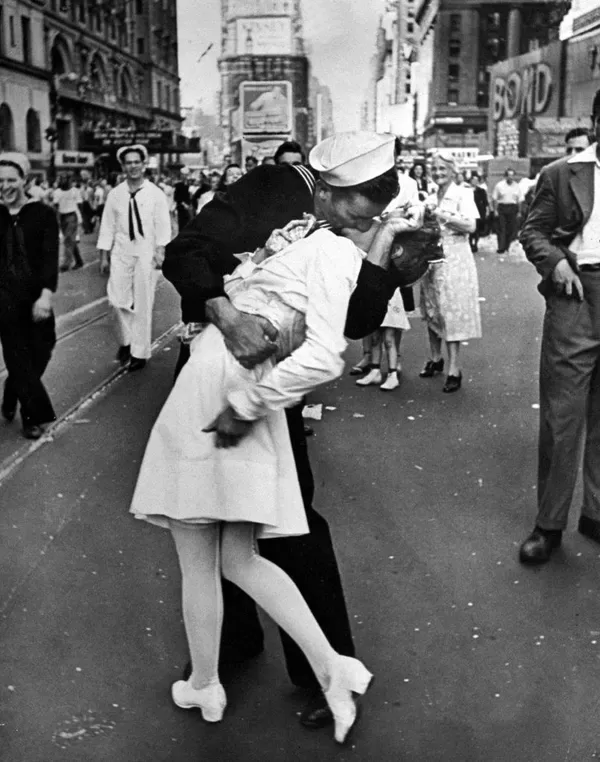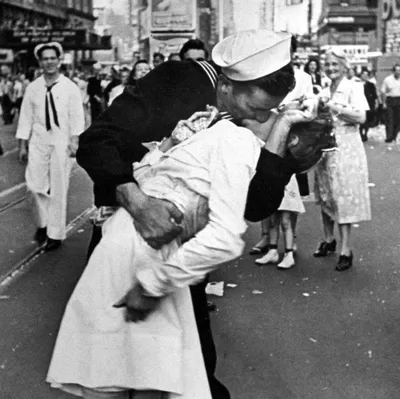“The Kiss” photograph, captured by Alfred Eisenstaedt, is one of the most iconic images in the history of photography. Taken on August 14, 1945, known as V-J Day, the day Japan surrendered to the United States, in Times Square, New York City, the photo captures a spontaneous moment of celebration marking the end of World War II.
Alfred Eisenstaedt, a German-born American photojournalist, was on assignment for Life magazine, documenting the euphoria and jubilation that erupted across the United States upon the announcement of Japan’s surrender, effectively ending the war. In the midst of the festivities in Times Square, Eisenstaedt spotted a sailor embracing and kissing a nurse passionately.


Alfred Eisenstaedt’s photo is called “V-J Day in Times Square” but is known to most people simply as “The Kiss.”
“The Kiss” quickly gained widespread popularity, gracing the cover of Life magazine and becoming an enduring symbol of the emotions felt by millions at the conclusion of World War II. Its timeless depiction of spontaneous celebration has made it an iconic image, symbolizing hope, unity, and the triumph of peace over conflict.
Alfred Eisenstaedt’s photo is called “V-J Day in Times Square” but is known to most people simply as “The Kiss.” While the photo has been celebrated as a symbol of joy and relief, it has also been scrutinized through a modern lens of consent and power dynamics.
Controversy over consent
The woman, Greta Zimmer Friedman, being kissed by a sailor, believed to have been George Mendonsa, said that the kiss was non-consensual, which sparked controversy.
Greta Friedman told the Library of Congress in 2005 “It wasn’t that much of a kiss; it was more of a jubilant act that he didn’t have to go back. I found out later he was so happy that he did not have to go back to the Pacific … and the reason he grabbed someone dressed like a nurse was that he just felt very grateful to nurses who took care of the wounded. It wasn’t a romantic event,” she added, “it was a ‘thank God the war is over.’ It wasn’t my choice to be kissed. The guy just came over and kissed or grabbed.”
Proponents of the #MeToo movement argue that the photograph represents a moment where the woman’s autonomy and consent are disregarded. They view the sailor’s action as a reflection of patriarchal entitlement, where men feel entitled to women’s bodies without their consent.
In the era of #MeToo, where the focus is on ending sexual harassment and assault, some argue that glorifying a photograph that seemingly depicts a non-consensual act perpetuates harmful attitudes towards women.
In March 2024, the US Veterans Affairs Department attempted to ban ‘The Kiss’ photograph by Alfred Eisenstaedt in their facilities.
RimaAnn O. Nelson, Assistant Under Secretary for Health for Operations, Veterans Health Administration, Department of Veterans Affairs sent a memo that said: “The photograph, which depicts a non-consensual act, is inconsistent with the VA’s no-tolerance policy towards sexual harassment and assault.”
“To foster a more trauma-informed environment that promotes the psychological safety of our employees and the veterans we serve, photographs depicting the ‘V-J Day in Times Square’ should be removed from all Veterans Health Administration facilities.”
The memo was circulated on social media and debate began around the “wokeness” of Nelson’s memo. Within hours, Veteran Affairs Secretary Denis McDonough overturned the decision. “Let me be clear: This image is not banned from VA facilities — and we will keep it in VA facilities,” he wrote on the social media platform X, formerly known as Twitter.
Let me be clear: This image is not banned from VA facilities – and we will keep it in VA facilities. pic.twitter.com/dYSikLxHAJ
— Secretary Denis McDonough (@SecVetAffairs) March 5, 2024
The photo above is by Navy photographer Victor Jorgensen which was published in The New York Times on the day after the celebration in Times Square. Jorgensen was one of the original six photographers recruited to join the Naval Aviation Photographic Unit during the war by Edward Steichen.
Alfred Eisenstaedt “The Kiss” photograph was published a week later in Life magazine in a 12-page section entitled “Victory Celebrations” with similar photographs of celebrators in Washington, D.C., Kansas City, and Miami.
Eisenstaedt talked about the moment he took the photo: “In Times Square on V.J. Day, I saw a sailor running along the street grabbing any and every girl in sight. Whether she was a grandmother, stout, thin, old, didn’t make a difference. I was running ahead of him with my Leica, looking back over my shoulder, but none of the pictures that were possible pleased me. Then suddenly, in a flash, I saw something white being grabbed. I turned around and clicked the moment the sailor kissed the nurse.”
#MeToo
Debating “The Kiss” photograph by Alfred Eisenstaedt in the context of the #MeToo movement involves examining its portrayal of romance and consent. “The Kiss” is an iconic image captured on V-J Day in 1945, depicting a sailor kissing a nurse in Times Square to celebrate the end of World War II.
Opponents may argue that interpreting “The Kiss” solely through the lens of #MeToo overlooks the historical context in which it was taken. The end of World War II was a time of immense celebration and heightened emotions, where social norms and behaviors were different from today.
They may argue that the sailor’s action was a spontaneous expression of jubilation rather than a deliberate act of harassment. Additionally, proponents may argue that imposing modern standards of consent on historical events risks erasing the complexities of the past.
Debating “The Kiss” photograph in the context of the #MeToo movement requires a nuanced understanding of historical context, cultural norms, and contemporary attitudes towards consent and power dynamics.
While some may view the image as problematic in light of modern standards, others may argue for a more balanced interpretation that considers the historical context in which it was taken. Ultimately, the debate prompts important discussions about the portrayal of romance, consent, and gender dynamics in visual media.
For some people, the image symbolises sexual harassment and assault, for others it was an iconic symbol of spontaneous joy, relief, and the end of conflict. Friedman died in 2016 at age 92. Mendonsa died in 2019 at age 95.
Since its capture, “The Kiss” has been reproduced countless times in various forms of media, and it continues to be celebrated as one of the most memorable and impactful photographs in history. Despite the passage of time, its message of joy and the universal desire for peace resonates with audiences around the world, ensuring its place in the annals of photographic history.
Related stories
Where did the term “Woke” come from? What does Woke mean?
Andre Kertesz, a pioneer of street & fine art photography
Sarah Moon, French fashion photographer
Sebastião Salgado lens on Humanity’s Struggle and Resilience
Dorothea Lange’s Pioneering Approach to Portraiture
Australia’s first professional photographer George B Goodman
This Working Photographer’s Life: Rob Walls
Man Ray’s love-hate relationship with Hollywood
Heinrich Hoffman photographs Adolf Hitler public speaking
Susan Sontag’s essay ‘Photography’ 50 years on
Was Peter Lik’s world record Phantom photograph a good deal
Robert Capa, a prolific & great war photographer
Gregory Halpern “somewhere between the documentary and fine art”







